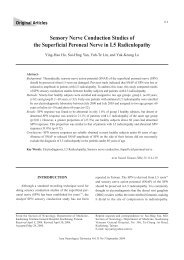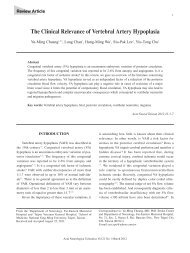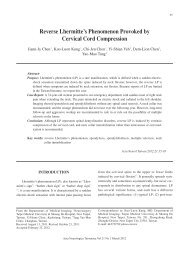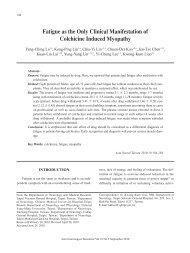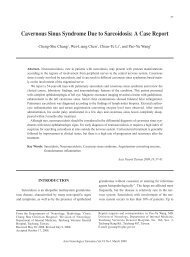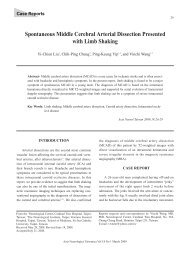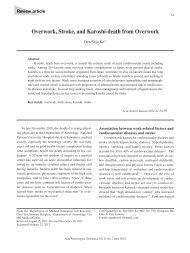Ramsay Hunt Syndrome with Hemiparesis and ... - Vol.22 No.1
Ramsay Hunt Syndrome with Hemiparesis and ... - Vol.22 No.1
Ramsay Hunt Syndrome with Hemiparesis and ... - Vol.22 No.1
Create successful ePaper yourself
Turn your PDF publications into a flip-book with our unique Google optimized e-Paper software.
278<br />
In another 2 weeks (day 25), decreased taste sensation,<br />
right facial hypoesthesia <strong>and</strong> right facial palsy developed<br />
<strong>with</strong> tearing from the right eye, easy choking, numbness<br />
<strong>and</strong> weakness of the right extremities. She came to our<br />
emergency room on the next day (day 26). Tiny crust <strong>and</strong><br />
scarring in the acoustic meatus <strong>and</strong> swelling of the right<br />
auricle were noticed. The right peripheral-type facial<br />
palsy was in Brackmann stage IV. Under the tentative<br />
diagnosis of <strong>Ramsay</strong> <strong>Hunt</strong> syndrome, oral valaciclovir<br />
(1000 mg tid) <strong>and</strong> prednisolone (60 mg qd) were prescribed<br />
for 3 days <strong>and</strong> she was discharged. Because the<br />
symptoms persisted, she was referred to the outpatient<br />
clinic of the department of neurology on day 33. In addition<br />
to the right peripheral-type facial palsy, there were<br />
dysphagia <strong>and</strong> motor-sensory deficits in the right limbs.<br />
Under the impression of <strong>Ramsay</strong> <strong>Hunt</strong> syndrome complicated<br />
<strong>with</strong> encephalitis, she was hospitalized on the<br />
same day, roughly one month after the onset of the first<br />
symptom.<br />
Complete neurological examination revealed right<br />
peripheral-type facial palsy, right hemiparesis (grade 4<br />
muscle power in both upper <strong>and</strong> lower limbs) <strong>and</strong> hypesthesia<br />
to vibration <strong>and</strong> pinprick (3/10 on the right side of<br />
the face, 5/10 in the right upper limb <strong>and</strong> trunk, <strong>and</strong> 7/10<br />
in the right lower limb). There was no dysmetria<br />
revealed by the finger-nose-finger or heel-knee-shin<br />
tests. The taste sensations to bitter, salty <strong>and</strong> sweet stimulants<br />
were intact. Her basic biochemistry data were<br />
<strong>with</strong>in normal limits. Lumbar puncture was performed<br />
smoothly on day 34. The open/close pressure was<br />
150/100 mmH 2<br />
O. The appearance of CSF was clear, but<br />
there were mildly elevated WBC (12/mm 3 , <strong>with</strong> 10 lymphocytes<br />
<strong>and</strong> 2 polymorphonuclear cells) <strong>and</strong> RBC<br />
counts (41/mm 3 ). The remaining CSF was sent for other<br />
studies, including sugar (77 mg/dL, 133 mg/dL in simultaneous<br />
serum sample), total protein (37 mg/dL) <strong>and</strong> lactate<br />
(1.6 mmol/L). Viral isolation of CSF <strong>and</strong> cotton<br />
swab of post-auricular skin both revealed negative result.<br />
VZV IgG <strong>and</strong> antigen were absent in the CSF. The<br />
evoked potential studies, including visual, sensory,<br />
motor <strong>and</strong> brainstem-auditory evoked potentials, were all<br />
normal. Facial nerve conduction velocity study <strong>and</strong> blink<br />
reflexes on day 35 confirmed the diagnosis of peripheral-type<br />
facial palsy on the right side. Mini-mental state<br />
examination showed a score of 28/30 <strong>and</strong> cognitive ability<br />
screening instrument 93/100, both being <strong>with</strong>in normal<br />
limits. MRI of the brain <strong>with</strong> <strong>and</strong> <strong>with</strong>out gadolinium<br />
was performed on day 34 <strong>and</strong> revealed no abnormality.<br />
Tc-99m single photon emission computed tomography<br />
showed no deficit of cerebral blood perfusion, either.<br />
Intravenous acyclovir (500 mg q8h) was given for 7 days<br />
from day 33. After treatment, the facial palsy improved.<br />
The muscle power of the right upper limb increased to 5-<br />
<strong>and</strong> the right lower limb to 4+. The pain sensation by<br />
pinprick improved to 10/10 on the face <strong>and</strong> 8/10 in the<br />
body <strong>and</strong> limbs.<br />
DISCUSSION<br />
RHS is a clinical syndrome that may include different<br />
combinations of symptoms. The core definition of<br />
RHS requires (1) herpes zoster auricularis or herpes<br />
zoster in any of the sensory zones corresponding to the<br />
trigeminal branches in the face, <strong>and</strong> (2) ipsilateral facial<br />
palsy. The definition of VZV encephalitis is confusing.<br />
According to the report of Kin et al. (6) , it requires impairment<br />
of consciousness <strong>and</strong> focal signs of the central nervous<br />
system. In addition, the symptoms should be associated<br />
<strong>with</strong> VZV infection, which had to be confirmed<br />
by clinical (herpes zoster) or laboratory findings (positive<br />
VZV DNA in CSF, anti-VZV IgM in CSF or a fourfold<br />
or greater increase in the anti-IgG titer in CSF<br />
obtained at an interval of at least 2 weeks). In other<br />
words, involvement of any structure or system in the<br />
central nervous system could be regarded as encephalitis.<br />
Kim et al. (7) reported a case of RHS complicated by a<br />
brainstem lesion (rhombencephalitis). The presentation,<br />
however, was regarded as the manifestation of nucleus<br />
invasion in cranial polyneuropathy in other reports (8,9) .<br />
Booss <strong>and</strong> Esiri (10) classified the neurological complications<br />
of herpes zoster infection into syndromes <strong>and</strong> circumstances.<br />
The syndromes included stroke, aseptic<br />
meningitis, cranial neuropathy/brain stem encephalitis,<br />
cerebellitis, encephalitis <strong>and</strong> myelitis. In this classification,<br />
encephalitis was more restricted to the impairment<br />
of consciousness <strong>and</strong> cognition.<br />
Acta Neurologica Taiwanica Vol 18 No 4 December 2009



